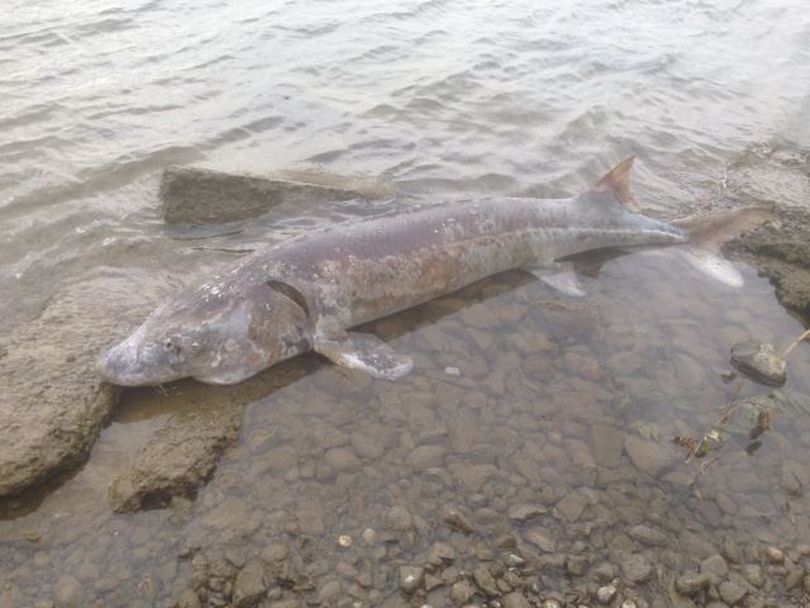Sturgeon deaths prompt Columbia fishing closure

FISHING -- As projected in this blog post yesterday, Columbia fish managers are closing sturgeon fishing on the chance that it might reduce the number of big sturgeon that are mysteriously going belly up this month. Here's a video showing some of the carnage followed by the story on today's action by Vancouver Columbian outdoor writer Allen Thomas:
By ALLEN THOMAS
The Vancouver Columbian
Spawning-size sturgeon are dying in the Columbia River Gorge reservoirs, prompting Washington and Oregon to close sturgeon angling upstream of Bonneville Dam beginning Saturday.
Five dead sturgeon have been documented in the Bonneville pool, 13 in The Dalles pool, 57 in John Day pool and five or more upstream of McNary Dam, Robin Ehlke, assistant Columbia River policy coordinator for the Washington Department of Fish and Wildlife, said at a joint state hearing today.
Specifically, the states adopted a closure starting Saturday of the catch-and-release sturgeon seasons between Bonneville and McNary dams, plus the retention fishery upstream of McNary Dam.
Retention fisheries in the Bonneville, The Dalles and John Day pools already have caught their harvest allocations.
Guy Norman, regional director of the Washington Department of Fish and Wildlife, said there is no evidence the sturgeon die-off is related to fish handling.
Ehlke said the Columbia River is 73 degrees, compared to a five-year average of 65 degrees for this time. Streamflows have been 137,000 cubic feet per second at Bonneville Dam compared to a five-year average of 287,000 cubic feet per second.
“It’s likely a batch of causes with high temperatures and low oxygen in the river stressing out these fish,’’ she said.
Sports groups wholeheartedly supported the closure.
“I’m in complete agreement although it cuts my throat financially,’’ said Jack LaFond, a fishing guide from The Dalles. “ I love these big fish and I don’t want to see them die or harmed in any way.’’
Sturgeon are a slow-growing fish.
“This broodstock takes decades to grow,’’ said Nathan Grim, a Tri-Cities sport-fishing activist.
John North of the Oregon Department of Fish and Wildlife called the large sturgeon in the Gorge “almost irreplaceable fish…Hopefully it won’t continue at this level.’’
Ehlke said 29 of the 57 John Day pool underwent biological examination.
Their bellies were full of sockeye salmon and their eggs were either ripe or beginning to be reabsorbed.
Sockeye headed for the Okanogan and Wenatchee rivers of north-central Washington are dying of columnaris, a bacterial infection typically associated with high water temperature and low levels of dissolved oxygen.
Ehlke said fish scientists say the chance of sturgeon catching columnaris by ingesting diseased sockeye is highly unlikely.
Most the dead sturgeon are large, spawning-size fish. State biologists estimate there are 3,000 sturgeon larger than 55 inches in the Bonneville pool, 1,300 in The Dalles pool and 2,800 in John Day pool.
Norman said almost all the dead sturgeon are 5-feet or longer.
Ehlke said a couple of years ago there was a die-off of sturgeon at the base of John Day Dam attributed to environmental conditions, A die-off occurred a few years ago in British Columbia’s Fraser River.
According to the report on the Fraser River die-off, oversize sturgeon have a slower metabolic rate and are less efficient at gilling oxygen from the water, she said.
The states were asked if the dead sturgeon were caused by being handled in treaty Indian commercial fishing nets.
North said aerial net counts saw no tribal nets between Crow Butte and McNary Dam on the last two flights. The upper end of John Day pool had the most dead sturgeon.
Washington announced it will close sturgeon fishing in the upper Columbia River and the Snake River beginning Saturday. Oregon today announced a closure of salmon, steelhead, trout and sturgeon fishing in the Willamette River downstream of Willamette Falls.
Catch-and-release sturgeon fishing in the Columbia River downstream of Bonneville Dam continues open.
